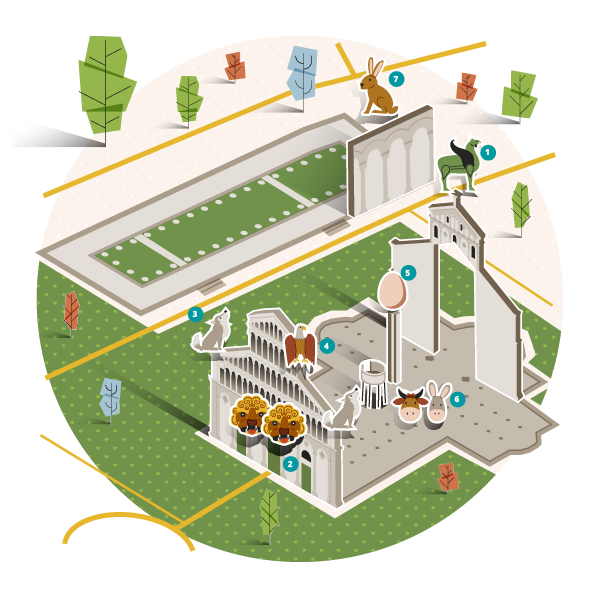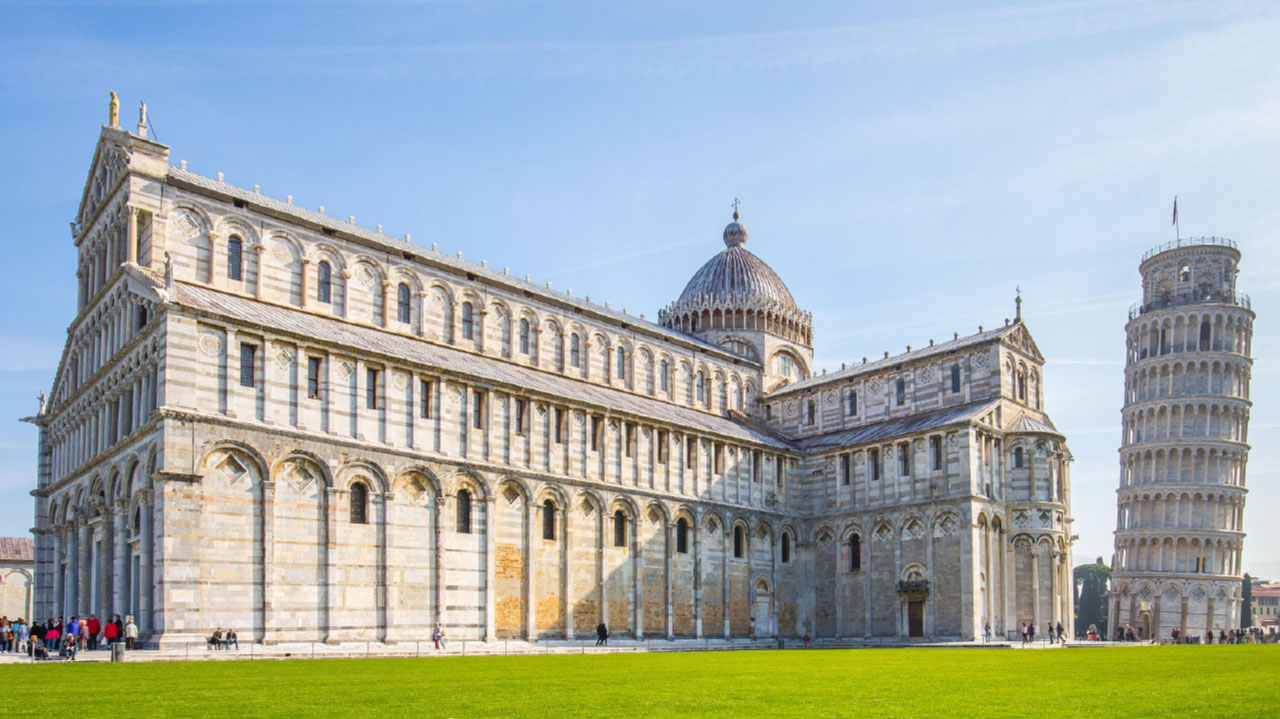PIAZZA DEL DUOMO, PISA

CULTURAL HERITAGE
It is difficult to resist the temptation of drawing fully from the theatrical vocabulary when in front of the sight of Piazza del Duomo in Pisa. Without the visual and spatial constrictions of an urban network, but free to breathe and move on the green stage of the grass, the monuments in the square seem summoned to dance in a choreography of stone, with the whimsical mutability of the Tuscan sky as the backdrop. In addition to its unique spatiality, the breathtaking quality of the site is the result of a feat which has lasted through the centuries and alternate stylistic phases, succeeding in harmonising its main buildings in a coherent vision. Like propaganda in marble, the square is also the materialisation of a historical phase which led the Republic of Pisa to monopolise commercial traffic in the Tyrrhenian Sea between the 11th and 12th centuries, up to the creation of an extensive trading network from the Balearic Islands to the Holy Land. Through the mesh of this net, stylistic lexicons which relate the cultural heterogeneousness of the medieval Mediterranean, with the coexistence of classical, Byzantine, Armenian and Arab influences converge towards the site of the Piazza dei Miracoli. The last major interventions date back to the end of the 13th century: in the climate of mature Gothic, the Baptistery is completed and work is started on the Monumental Cemetery, of which the magnificent cycles of frescos are one of the masterpieces of painting between the 14th and 15th centuries
NOT TO BE MISSED
“The majestic cathedral of Santa Maria Maggiore shone in the night like a ghost, with its white marbles looted after the victory over the Saracen city of Palermo.”
This is how Francesca Ramacciotti describes the Duomo in I custodi della pergamena del diavolo, an impression which has resisted the passing of the centuries.
Google Maps
“Cast your eye, if you are not dazzled, on
its river glowing as with fire, then follow the
graceful curve of the palaces on the Lung’ Arno
[…], and tell me if anything can surpass
a sunset at Pisa.”
Surrounded by the literary evocations of the Arno’s banks, it is easier to catch from the shores and bridges the words cast into the waters of the river by generations of travellers. In 1821, Lord Byron and Percy Shelley lived in Palazzo Lanfranchi (today Toscanelli) on Lungarno Mediceo, giving birth to a group of exiled spirits known as the Pisan Circle. The banks of the Arno left a similar impression on Giacomo Leopardi, who wrote to his sister Paolina in 1827: “This bank of the Arno is such a broad sight, so magnificent, so cheerful and so smiling that he falls in love with it […]”.
Listen to the podcasts
The Italian UNESCO Heritage sites tell their story through the words of great writers who have celebrated their history and beauty
Listen to all episodesFOR YOUNG EXPLORERS
“MISTAKES ARE NECESSARY, THEY ARE USEFUL LIKE BREAD AND OFTEN ALSO LOVELY: FOR EXAMPLE THE TOWER OF PISA.”


READING RECOMMENDATIONS
Suggestions for further reading to learn more about Piazza dei Miracoli.
- Conversations of Lord Byron, Thomas Medwin (1824). A collection of memoirs about Lord Byron and Percy Bysshe Shelley’s stay in Pisa.
- Epistolario, Giacomo Leopardi (1849). A collection of over 900 letters written between 1810 and 1837: a pivotal document on the poet’s life.
- Notebooks, Albert Camus (2010). From 1935 until his premature death, Albert Camus filled many notebooks which lump together impressions, creative ideas, reflections and travel notes, “alchemical substances” which outline, together with a spontaneous autobiography, the literary work of the author.
- My brilliant friend, Elena Ferrante (2012). In the second chapter of the saga, The story of a new name, Lila and Lenù face the social and physical constraints of their neighbourhood. Lila stays in Naples but Lenù goes to study in Pisa at the Scuola Normale Superiore, amid crucial encounters and the first seeds of student protests.
- Etica dell’acquario, Ilaria Gaspari (2015). When Gaia returns to Pisa after having been away for ten years, it is not only her old friends who are waiting for her, but also the ghost of a fellow friend’s suicide. Between the squares and the streets in the centre and the ivory tower of the University, this philosophical noir, the debut novel by a graduate of the Scuola Normale Superiore, is an investigation into that mysterious death.
- Scacco alla Torre, Marco Malvaldi (2015). The author of the very successful series of thrillers, in which the jaunty pensioners of the BarLume are busy solving crimes in the imaginary town of Pineta, writes about his real Pisa in the laid-back and witty style that distinguishes him.
- I custodi della pergamena del diavolo, Francesca Ramacciotti (2019). In 1174, the architect Diotisalvi is working on the Tower. The gold from the Porta Aurea is stolen and terror invades a Pisa tormented by a series of mysterious murders. The investigations take place on a double time level in a city which has kept an enigma secret for almost a thousand years.
- Randagi, Marco Amerighi (2021). Pisa is the setting for the existential crisis of Pietro Benati, who is waiting to die as predicted by a curse on the males of the family. When it is his brother who dies, however, his only strength remains his bond with the stray and rootless humanity which is the world to which he has always belonged.
Children’s books:
- Il libro degli errori, Gianni Rodari (1964). With spelling that is quite unorthodox, but very inventive, and his usual desecrating and non-conformist spirit, Gianni Rodari compiles a manual of stories, short tales and nursery rhymes all characterised by a mistake, giving rise to a zany linguistic merrygo-round of moving poetry.
- L’Enigma di Agata, Roberta Baroni, Stella Robi (2022). At the Pisa Book festival, three close friends have to find the eccentric Aunt Agata who has disappeared, like the jewellery in her book.

Download the digital book and explore Italy's 60 UNESCO sites through the words of renowned authors from Italian and world literature.
SINGLE CHAPTER PDF FULL BOOK PDF FULL BOOK EPUB